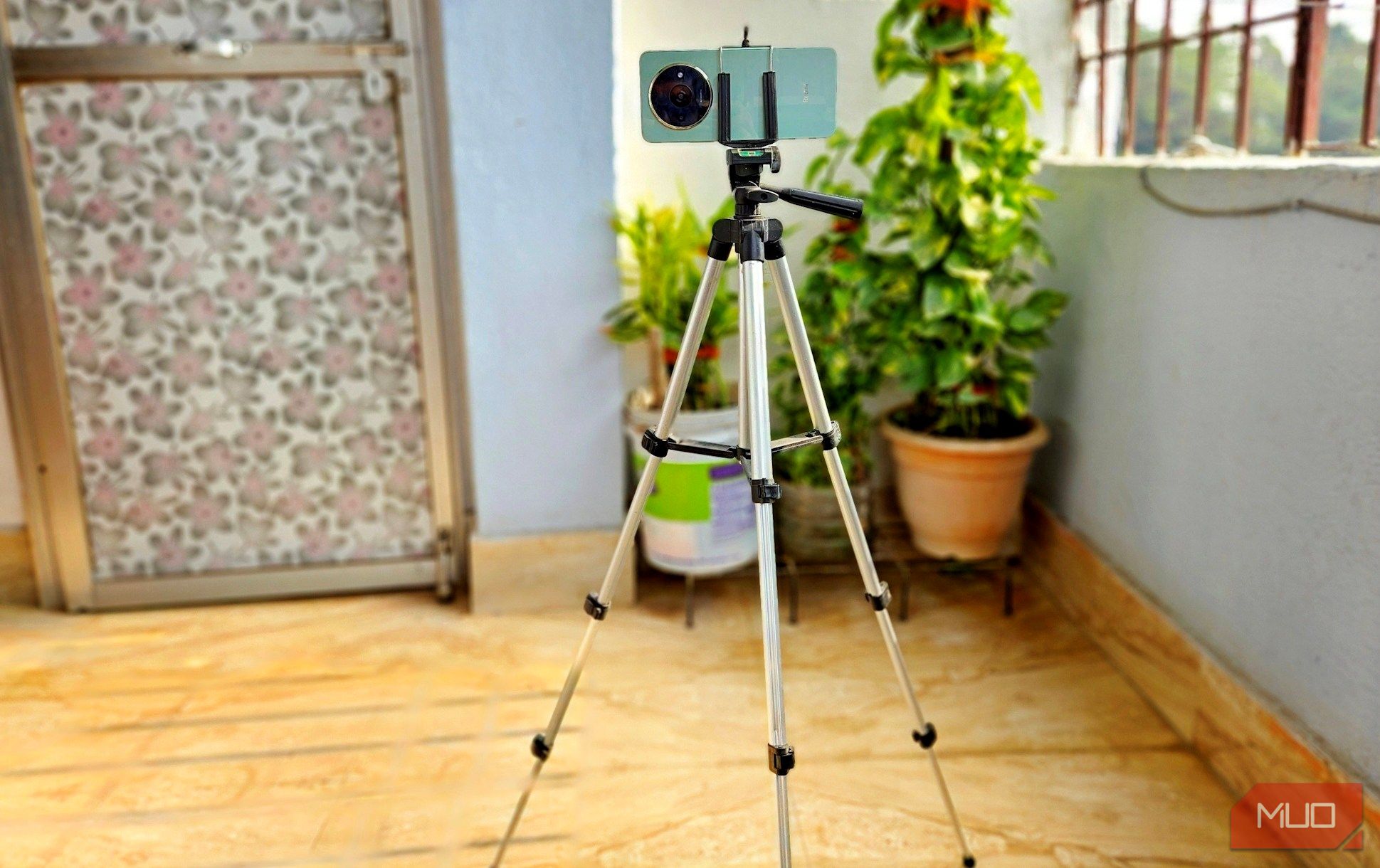Night photography requires a different approach than daytime. Limited light, shaky hands, and noise can cause blurry and grainy photos. However, with the right techniques, you can capture crisp and clear night shots on your phone—sometimes even better than a professional camera.
1
Use a Tripod or Stabilizer
Shooting in low light requires a steady base to prevent motion blur since even slight movements can ruin a great shot. That’s why I always use a tripod for night photography. It lets me play around without fear of the camera shaking. It keeps things steady and cuts down on blur in the final image.
If I don’t have a tripod, I use solid surfaces like walls or rocks to keep the camera steady. Plus, I use the timer on my camera app to avoid any minor shakes that might happen when pressing the shutter button. Setting it for a few seconds gives me enough time to take my hand off the phone before the photo snaps.
Another cool gadget for steady night shots is a stabilizer or gimbal. These handheld devices help me get smooth and steady shots, even when walking or moving. They’re compact and portable, giving way better stability than just using my hands. Some even come with remotes for easier hands-free shots. Light trails, city lights, and night skies look gorgeous with these things.
2
Clean Your Camera Lens
For a crisp night shot, make sure your lens is clear. Dust, smudges, or fingerprints can mess up image quality. Even if your camera is steady, a dirty lens makes the photo blurry. It takes just a few seconds to clean, but it makes a big difference in the final image.
When I do night photography, I clean my lens thoroughly. I use a microfiber cloth to wipe away dust or smudges—it’s gentle and won’t scratch the lens. I wipe in circular motions from the center outward, then gently blow on the lens to remove debris left behind.
Things like tissues and paper towels can scratch your lens, so it’s best to skip those. Also, try not to touch the lens with your fingers—skin oils can leave streaks.
3
Avoid Flash and Direct Light Sources
Flash might seem useful for night shots, but usually, it’s not. It throws in harsh, unnatural light that washes out colors and textures. Instead, try using the natural or artificial light already there. Street lamps, building lights, and even moonlight can add some cool ambiance to night shots.
If you need more light, try using a diffuser or bounce card to soften things up. Direct light sources, like car headlights or bright spotlights, can mess up your night shots. They create strong shadows and lens flares that ruin the composition. To fix this, adjust your camera angle to reduce direct light or use a longer exposure o capture light trails.
4
Manually Adjust Exposure
Exposure is all about how much light gets into the camera when you snap a photo. Too much light gives you an over-exposed shot, while too little makes it dark. Achieving the correct exposure is key to those nice-looking pics.
In low-light spots, cameras often brighten things to grab more details, which can make bright areas over-exposed and dark regions look grainy. So, it’s a good idea to manually tweak the exposure in these situations to get the desired result.
To adjust the exposure manually, just tap on the screen where you want to focus. This will set the exposure for that spot, too. Once you’ve focused, you’ll notice a sun icon next to the focus square. Slide it up (+) to brighten your shot or down (-) to darken it. This way, you can adjust how much light your photo captures.
To my knowledge, there’s no precise formula for getting exposure just right. It’s usually a game of trial and error until you hit that sweet spot for a photo. A good tip, though, is to lower the exposure when shooting at night. It makes the image darker, but you’ll get true blacks and more detailed highlights.
5
Enable Night Mode or Tweak HDR Settings
Almost all smartphones these days come with Night Mode cameras. Some brands might call it Low Light or Night Sight, but they all do the same thing. This feature detects low-light conditions and adjusts the camera settings accordingly. It might increase the exposure time, slow down the shutter speed, or snap multiple pics and merge them into one great shot.
This way, you can get clear night pictures without needing extra gear. Just be careful about motion blur if you or your subjects move. To avoid that, I usually use a tripod or prop my phone on something steady.
Another option is to tweak your phone’s HDR (High Dynamic Range) settings. HDR snaps multiple shots at different exposures and blends them for a photo with better lighting, contrast, and details. So, even in low light, HDR mode can give you surprisingly good results. Just remember, it might take a bit longer to process, so keep your phone steady until it’s done.
6
Use Pro Mode for More Control
The Pro Mode on a smartphone camera allows you to control different settings manually. Unlike auto mode, where the camera decides everything, Pro Mode puts you in charge of your photography. This feature is usually found on high-end smartphones, where you can tweak shutter speed, ISO, and white balance yourself.
When I shoot at night, I usually go for a longer shutter speed, like 1/4 to several seconds. This lets more light into the camera, giving you a brighter shot. But watch out—longer shutter speeds can blur your photos if your hands aren’t steady. I use a tripod or put my phone on something stable to avoid that.
ISO is another key setting to consider when doing night photography. It adjusts how sensitive your camera’s sensor is to light. In Pro Mode, I typically keep it between 400 and 800 to let in more light while still maintaining a decent image quality. A higher ISO might make your photos grainy or noisy, so it’s all about finding the sweet spot.
My last setting is white balance, which controls the color temperature of my photos. I prefer a warmer tone for night shots, so I usually set it to around 4000. This adds some warmth and makes the image more pleasing to the eye.
7
Shoot in RAW Format
The RAW format is like the digital version of a film negative. It captures and stores raw data from the camera’s sensor without compression or processing. This means you get the highest quality image possible and tons of flexibility when editing.
With a RAW file, I get full control over the final image. I can tweak exposure, white balance, and color temperature without sacrificing quality or detail. Unlike JPEGs, which are compressed and lose data every time you edit them, RAW files retain their data and can be edited multiple times without losing quality.
It’s all about finding the right balance between your settings and experimenting with it until you get the perfect shot. So, try them out and see how they work for you.









